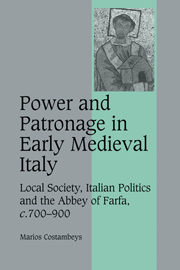 Power and Patronage in Early Medieval Italy
Power and Patronage in Early Medieval Italy Book contents
- Frontmatter
- Contents
- List of illustrations
- Acknowledgements
- Note on charter editions
- List of abbreviations
- Maps
- 1 INTRODUCTION
- 2 PATRONAGE AND LOMBARD RULERS
- 3 AUTHORITY, RULERSHIP AND THE ABBEY
- 4 THE MONKS AND ABBOTS OF FARFA: IDENTITIES AND AFFILIATIONS
- 5 SABINE LANDS AND LANDOWNERS
- 6 ELITE FAMILIES IN THE SABINA
- 7 FARFA AND ITALIAN POLITICS IN THE LOMBARD ERA
- 8 FARFA, ITALIAN POLITICS AND THE CAROLINGIANS
- Bibliography
- Index
- Cambridge Studies in Medieval Life and ThoughtFourth Series
2 - PATRONAGE AND LOMBARD RULERS
Published online by Cambridge University Press: 17 July 2009
- Frontmatter
- Contents
- List of illustrations
- Acknowledgements
- Note on charter editions
- List of abbreviations
- Maps
- 1 INTRODUCTION
- 2 PATRONAGE AND LOMBARD RULERS
- 3 AUTHORITY, RULERSHIP AND THE ABBEY
- 4 THE MONKS AND ABBOTS OF FARFA: IDENTITIES AND AFFILIATIONS
- 5 SABINE LANDS AND LANDOWNERS
- 6 ELITE FAMILIES IN THE SABINA
- 7 FARFA AND ITALIAN POLITICS IN THE LOMBARD ERA
- 8 FARFA, ITALIAN POLITICS AND THE CAROLINGIANS
- Bibliography
- Index
- Cambridge Studies in Medieval Life and ThoughtFourth Series
Summary
THE DUKES OF SPOLETO
This chapter will examine the operation of the political power claimed by rulers in the Sabina up to the mid-ninth century. This involves two basic questions: how did Lombard rule work? And, how did the impact of rulership on local society change after the arrival of Carolingian power in central Italy in 774? Like Lombard Italy as a whole, the political history of the duchy of Spoleto has been told in terms of the operation of a governmental structure, headed by the duke, the origins of which may be hard to trace, but which can be reconstructed fairly completely for the eighth century, here largely on the basis of the Farfa documentation. In this view, power flowed through the capillaries of this structure in one direction: down from the ducal palace in Spoleto to every corner of the duchy. The dominant narrative follows the changing identity of the dukes from independence to affiliation with the kings in the north, and back. The range of personalities on whose political activities the Farfa documents offer a window, suggests that this narrative fails fully to acknowledge the complexity of the distribution of power in the Sabina. The dukes were certainly among such personalities, but it would be assuming too much automatically to ascribe the major role in the development of the Sabina in the eighth and early ninth centuries to their initiative or influence.
- Type
- Chapter
- Information
- Power and Patronage in Early Medieval ItalyLocal Society, Italian Politics and the Abbey of Farfa, c.700–900, pp. 62 - 89Publisher: Cambridge University PressPrint publication year: 2007


